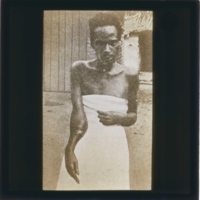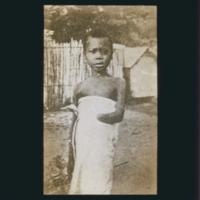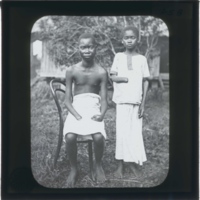
Photo of African Man, taken by W.D. Armstrong
Unknown. This photograph was taken by W. D. Armstrong.This image formed part of the Harris Lantern Slide Collection. Under King Leopold II the Congo Free State used mass forced labour to extract rubber from the jungle for the European market. As consumer demand grew King Leopold II's private army - the Force Publique - used violent means to coerce the population into meeting quotas, including murder, mutilation, rape, village burning, starvation and hostage taking. Alice Seeley Harris and her husband Reverend John H. Harris were missionaries in the Congo Free State from the late 1890s. Alice produced a collection of images documenting the horrific abuses of the African rubber labourers. Her photographs are considered to be an important development in the history of humanitarian campaigning. The images were used in a number of publications. The Harrises also used the photographs to develop the Congo Atrocity Lantern Lecture which toured Britain and the the USA raising awareness of the issue of colonial abuses under King Leopold II's regime.Source: Antislavery International.

Lokota of Mpelengi
The child in the photo was called Lokota of Mpelengi and was mutilated by soldiers in the course of a raid from ABIR militia (Anglo-Belgian India Rubber Company) in the Belgian Congo in 1903. Lokota was brought to see Roger Casement on 7 September 1903 at the Mission at Bonginda. He was photographed by W. D. Armstrong. Lokota was a toddler when he was mutilated. The village Mpelengi (about three miles away from the Mission) was attaked when the people failed to meet their rubber quota. Four sentries - Mokwolo, Ebomi, Mokuba, Bomolo - killed the chief Eliba. The villagers fled but Lokota fell and was mutilated by Mokwolo on being caught. This photograph was the first Congo atrocity image to be published by in the missionary magazine Regions Beyond in January 1904. This photograph (Neg. 119) formed part of the Harris Lantern Slide Collection. Under King Leopold II the Congo Free State used mass forced labour to extract rubber from the jungle for the European market. As consumer demand grew King Leopold II's private army - the Force Publique - used violent means to coerce the population into meeting quotas, including murder, mutilation, rape, village burning, starvation and hostage taking. Alice Seeley Harris and her husband Reverend John H. Harris were missionaries in the Congo Free State from the late 1890s. Alice produced a collection of images documenting the horrific abuses of the African rubber labourers. Her photographs are considered to be an important development in the history of humanitarian campaigning. The images were used in a number of publications. The Harrises also used the photographs to develop the Congo Atrocity Lantern Lecture which toured Britain and the the USA raising awareness of the issue of colonial abuses under King Leopold II's regime. Source: Antislavery International and Panos Pictures. A account of Lokota's experiences can be read in E. D. Morel

A Young Man and Child with Severed Limbs
A young man and child with severed arms. Mola (seated) had his hands destroyed by gangrene after being tied too tightly by soldiers. Yola (standing) was mutilated by soldiers who wanted to prove they had used the bullet to kill a rubber labourer. This photograph was taken by W. D. Armstrong. This image formed part of the Harris Lantern Slide Collection. Under King Leopold II the Congo Free State used mass forced labour to extract rubber from the jungle for the European market. As consumer demand grew King Leopold II's private army - the Force Publique - used violent means to coerce the population into meeting quotas, including murder, mutilation, rape, village burning, starvation and hostage taking. Alice Seeley Harris and her husband Reverend John H. Harris were missionaries in the Congo Free State from the late 1890s. Alice produced a collection of images documenting the horrific abuses of the African rubber labourers. Her photographs are considered to be an important development in the history of humanitarian campaigning. The images were used in a number of publications. The Harrises also used the photographs to develop the Congo Atrocity Lantern Lecture which toured Britain and the the USA raising awareness of the issue of colonial abuses under King Leopold II's regime.Source: Antislavery International and Panos Pictures. An account of Mola's experiences can be read in E. D. Morel, King Leopold's Rule in Africa (London: Heinneman, 1904), pp. 378-79.